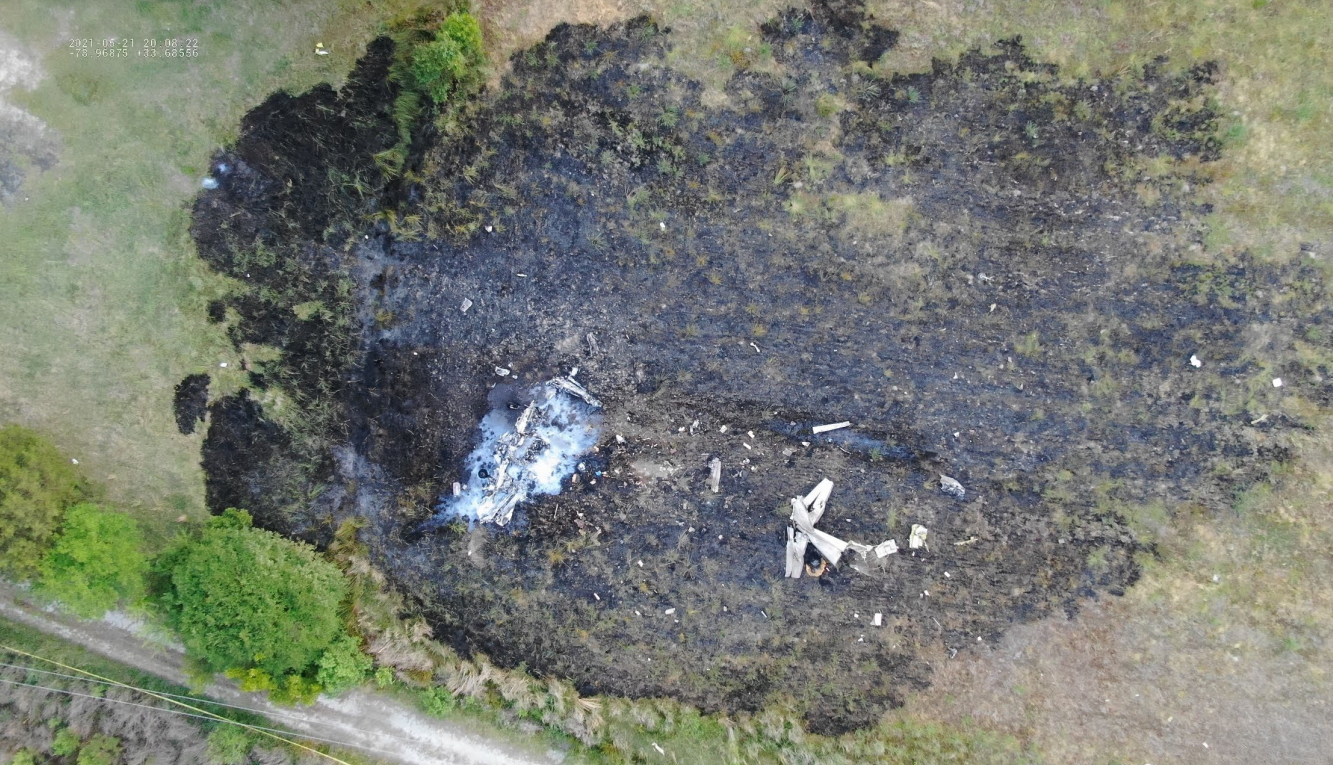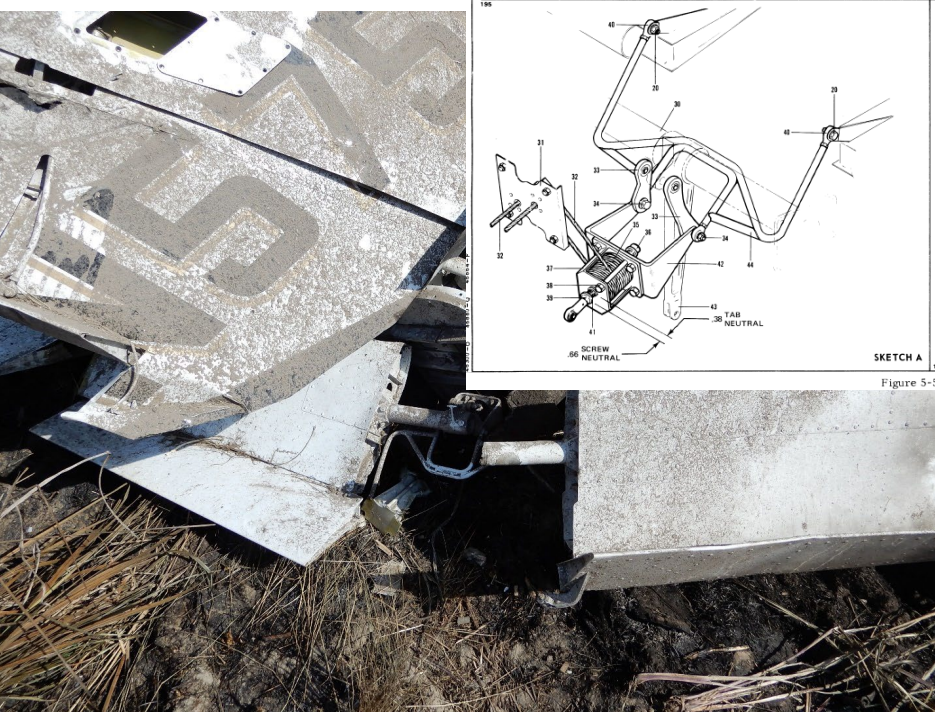
ASN Wikibase Occurrence # 262221
This information is added by users of ASN. Neither ASN nor the Flight Safety Foundation are responsible for the completeness or correctness of this information.
If you feel this information is incomplete or incorrect, you can submit corrected information.
| Date: | Friday 21 May 2021 |
| Time: | 18:14 |
| Type: |  Piper PA-31P-425 Pressurized Navajo |
| Owner/operator: | PJS LLC |
| Registration: | N575BC |
| MSN: | 31P-7730004 |
| Year of manufacture: | 1977 |
| Total airframe hrs: | 4826 hours |
| Engine model: | Lycoming TIGO-541-E1A |
| Fatalities: | Fatalities: 1 / Occupants: 1 |
| Aircraft damage: | Destroyed |
| Category: | Accident |
| Location: | near Myrtle Beach International Airport (MYR/KMYR), SC -
 United States of America United States of America
|
| Phase: | Initial climb |
| Nature: | Private |
| Departure airport: | Myrtle Beach International Airport, SC (MYR/KMYR) |
| Myrtle Beach-Grand Strand Airport, SC (CRE/KCRE) | |
| Investigating agency: | NTSB |
| Confidence Rating: |
On May 21, 2021, at 1814 eastern daylight time, a Piper PA-31P, N575BC, was destroyed when it was involved in an accident near Myrtle Beach, South Carolina. The airline transport pilot was fatally injured. The airplane was operated as a Title 14 Code of Federal Regulations Part 91 personal flight.
The accident flight was the first flight after an annual inspection during which all flight control surfaces were removed, repainted, and reinstalled. After departure, the pilot reported that he needed to return to the runway. The airplane’s altitude fluctuated between 1,000 ft and 450 ft mean sea level before radar contact was lost. Examination of the engines and propellers revealed no mechanical failures or anomalies that would have precluded normal operation. Examination of the airframe revealed that the elevator trim tabs were installed upside-down and reversed, which would have resulted in the tabs moving opposite of the intended direction. A command from the cockpit controls for nose-up trim would result in the tabs moving in the airplane nose-down direction and vice versa. As found, both trim tabs were deflected trailing edge up, which corresponded to a nose-down trim setting.
The mechanic who approved the airplane to be returned to service stated that, after the control surfaces were reinstalled, he examined the primary flight controls for proper movement but did not verify proper movement of the elevator trim tab. Although the control surfaces were tagged with labels as they were removed, those labels likely did not remain attached throughout the painting process, which contributed to their improper reinstallation.
The maintenance facility also maintained a different version of the accident airplane, which was designed with the elevator trim tab control rod and control horn positioned on the bottom of the trim tab. It is possible that the mechanic may have thought the trim tab installation on the accident airplane was the same, which could explain why the mechanic inadvertently installed the elevator trim tabs in reverse. Although the illustrated parts catalog (IPC) warned in the introduction section that the IPC should not be used for rigging and installation purposes, a figure on a subsequent page of the IPC incorrectly depicted the elevator trim tab control horn positioned on the bottom side of the elevator trim tab. Had the mechanic referred to this figure, it may have contributed to the incorrect installation of the trim tabs.
It is likely that the pilot applied nose-up trim during takeoff, and subsequently experienced nose-down trim forces due to the improper installation of the trim tab. After 2 minutes of flight, the pilot was unable to maintain control of the airplane, possibly due to the unexpected control forces, which resulted in a rapid descent and collision with terrain.
Toxicology testing detected ethanol in the pilot’s liver (0.225 and 0.078 gm/hg) and muscle tissue (0.144 gm/hg). Another postmortem microbial product, propanol, was detected in his liver tissue by one laboratory and in muscle tissue by a second laboratory. When consumed, ethanol distributes quickly and uniformly to body tissues based on water content. One would expect the concentrations in the two liver tissue samples to be similar and the concentrations in liver and muscle tissue to be similar as well. Given the different ethanol tissue concentrations, the state in which the body was recovered, and the presence of n-propanol in liver and muscle tissue, it is likely that the identified ethanol was from sources other than ingestion. Thus, the identified ethanol did not contribute to this accident.
Probable Cause: The mechanic’s inadvertent installation of the elevator trim tabs in reverse, which resulted in the pitch trim system operating opposite of the pilot’s input and the pilot’s subsequent loss of control.
Accident investigation:
 |
|
Sources:
https://wpde.com/news/local/rescue-crews-respond-to-airplane-crash-in-horry-county-near-highway-707
https://www.wbtw.com/news/grand-strand/crews-on-scene-of-reported-plane-crash-near-highway-707-in-socastee/
https://www.wmbfnews.com/2021/05/21/multiple-crews-respond-small-plane-field-along-socastee-boulevard-horry-county/
https://www.myhorrynews.com/news/avoid-the-area-crews-respond-to-airplane-crash-in-myrtle-beach-area/article_d6edbc86-ba87-11eb-bdd1-236b5870d62b.html
NTSB
https://globe.adsbexchange.com/?icao=a76118&lat=33.692&lon=-78.963&zoom=13.4&showTrace=2021-05-21
https://registry.faa.gov/aircraftinquiry/Search/NNumberResult?nNumberTxt=575BC
https://flightaware.com/live/flight/N575BC
https://s3.eu-west-2.amazonaws.com/abpic-media-eu-production/pictures/full_size_091/1137814-large.jpg (photo)
Location
Images:


Photo: NTSB, View Elevator Trim Tabs. Note elevator trim tab attach points are on the bottom of the elevator trim tab as compared to the PA-31P maintenance manual where the trim tab attach points are on the top of the elevator trim tab.
Media:
NTSB is investigating the May 21, 2021, crash of a Piper PA31 airplane near Myrtle Beach, SC. NTSB investigator expected to arrive on scene Sat., May 22, 2021.
— NTSB_Newsroom (@NTSB_Newsroom) May 22, 2021
Revision history:
| Date/time | Contributor | Updates |
|---|---|---|
| 22-May-2021 04:23 | Geno | Added |
| 22-May-2021 04:24 | Geno | Updated [Aircraft type] |
| 22-May-2021 04:28 | Geno | Updated [Source, Narrative] |
| 22-May-2021 05:24 | RobertMB | Updated [Aircraft type, Location, Phase, Nature, Destination airport, Source, Narrative] |
| 22-May-2021 14:20 | Anon. | Updated [Location, Source, Narrative] |
| 22-May-2021 15:50 | Captain Adam | Updated [Location, Embed code, Narrative] |
| 24-May-2021 13:48 | Anon. | Updated [Embed code] |
| 01-Jun-2021 11:12 | SANMJN | Updated [Embed code] |
| 09-Jun-2021 11:35 | Dmitriy | Updated [Narrative] |
| 20-Jul-2021 18:17 | aaronwk | Updated [Source, Embed code] |
| 13-Aug-2022 11:20 | Captain Adam | Updated [Source, Narrative, Category, Accident report, Photo] |
| 13-Aug-2022 11:21 | Captain Adam | Updated [Photo] |
Corrections or additions? ... Edit this accident description
The Aviation Safety Network is an exclusive service provided by:


 ©2024 Flight Safety Foundation
©2024 Flight Safety Foundation